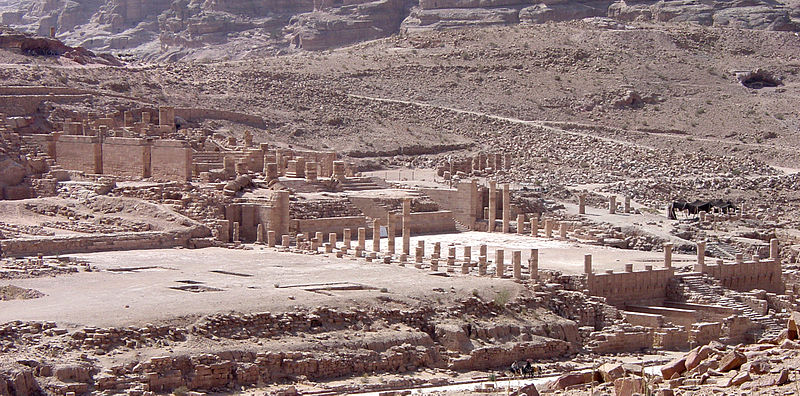
Great Temple
Petra, Jordan
Plan of the Great Temple

|
Great TemplePetra, Jordan
|
The Great Temple is situated in the city center, east of Qasr al-Bint and south of the Colonnaded Street. This is a view from near Petra Church, looking south and west from the rise across the Colonnaded Street.
The symmetry of the building (see plan, above) adds greatly to its attractiveness. Its outer walls measure 54m x 140m. It is constructed on two levels. Stairs lead up from the street to a large colonnaded courtyard (lower temenos, or lower terrace). More stairs lead up from the courtyard to an upper terrace with remains of a columned hall and a small theater.
The site was built out in two phases. The upper terrace was constructed first, sometime in the first century BC. It connected to the street by a central staircase. Upon the terrace, a building was raised that early surveyors first interpreted as a temple but that now looks, after further work, more like an assembly hall of some kind.
The second phase of construction occurred sometime in the first century AD. A lower terrace was cut below the original one, obliterating the central staircase, and a retaining wall was built to separate the two levels. The new terrace was lined on each side by a roofed triple colonnade with exedra, and connected to the upper terrace by new stairways on either side. The upper terrace was also remodeled at this time, when the interior of its columned hall was converted into a small theatre.
In spite of its name, it is not at all certain that the Great Temple was actually a temple, even though an altar was excavated in 2000 from the lower terrace. In Greek and Roman peripteral temples, the cella encloses a cult statue and is surrounded by columns (Greek Temple Plan). On the upper terrace of the Great Temple, however, one finds a theatre instead of a god, and columns inside the walls instead of outside them. Some writers have suggested that the upper terrace may have begun life as a temple, and been remodeled later for secular use; however, such a conversion is otherwise unknown in the ancient world. More plausibly, the upper terrace may have started out as an audience or meeting hall, afterwards converted into a council chamber (bouleterion) with the addition of the theatre. The lower terrace, surrounded by its roofed colonnade, could have been a forum (every good Roman town had to have one) and a space for public assemblies and ceremonies.
For information about the "Lower Market" adjoining the Great Temple complex, see: The Pool-Complex At Petra (Lower Market Survey, 1998, Preliminary Report) by Leigh-Ann Bedal, Anthropology Department, University of Pennsylvania.
The Great Temple was severely damaged by unspecified causes around 300 AD, and totally collapsed in the earthquake of 363 AD. Brown University began excavation only in 1993, and there remains much to explore in connection with this unique and very interesting edifice.

|

|